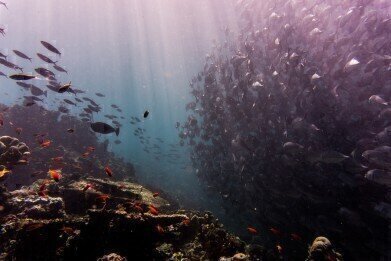Environmental laboratory
What Has Happened to the Great Barrier Reef?
Oct 21 2016
2016 has not been a good year for Australia’s biggest tourist attraction and the world’s largest living organic structure. The Great Barrier Reef, once the colourful, distinctive icon of coral reefs across the world, has been ravaged by a serious of environmental events and political decisions which threaten its very existence.
Though the Reef is not completely dead yet, much of it has been damaged beyond repair and a significant majority has suffered serious consequences from events over the last 12 months. Here’s a quick rundown of the catastrophes that have befallen this ailing marvel of nature.
El Niño
Beginning back at the start of 2015, El Niño reached almost record-breaking limits up until its eventual dissipation in June 2016. The phenomenon pushed up surface ocean temperatures by approximately 1.5°C in places, wreaking havoc on sections of the Reef.
The unique composition of coral skeletons makes them susceptible to elevated temperatures. In such instances, the coral will reject the algae which lives upon it and which provides it with sustenance. Though coral can survive for a time without the algae, it will quickly lose its bright colour (hence the name “bleaching”) and if deprived of algae for a prolonged period of time, will eventually die out altogether.
The worst bleaching event in history
Unfortunately, many parts of the Great Barrier Reef reached that critical point of no return this year. Indeed, in northern parts of the Reef (which experience warmer oceanic temperatures all of the time), as much as 50% of the coral is thought to have been killed off with no hope of revival. Such a staggering percentage is a huge loss to the ecosystem.
Though the north might have suffered the brunt of the bleaching, it was far from the only affected area. In fact, the National Oceanic and Atmospheric Administration (NOAA) has estimated that 93% of the whole Great Barrier Reef has been affected by partial or total bleaching during this year.
The worst part? There appears to be no end in sight, with experts predicting there is over a 90% chance that bleaching will extend into 2017.
Australian negligence
To exacerbate affairs, the Australia government appears determined to ignore the problem entirely. Just as the crisis was reaching a critical condition in late 2015 and the bleaching was receiving peak media attention, the government gave its seal of approval to a coal port expansion plan at Abbot Point, which is right in the epicentre of this unfolding turmoil.
Indeed, they even went as far as to urge the UN to censor a report in which they named the Great Barrier Reef as one of the most under-fire natural sites in the worldwide, fearing it would have a detrimental impact on tourism. Of course, the fact is that ignoring the issue completely will almost certainly ensure the demise of the Reef altogether, thus losing $6 billion annually and 69,000 jobs in the industry.
Action is needed – now
The Great Barrier Reef is not just a beautiful tourist attraction, of course. It’s also a natural archive of environmental and climate change, a living structure in its own right and home to 25% of all marine life in the area. Continuing to ignore its deteriorating condition will only hasten its demise – and make the whole world poorer for its loss.
Digital Edition
IET 35.2 March
April 2025
Air Monitoring - Probe Sampling in Hazardous Areas Under Extreme Conditions - New, Game-Changing Sensor for Methane Emissions - Blue Sky Thinking: a 50-year Retrospective on Technological Prog...
View all digital editions
Events
Apr 21 2025 Shanghai, China
Apr 22 2025 Hammamet, Tunisia
Apr 22 2025 Kintex, South Korea
Analytica Anacon India & IndiaLabExpo
Apr 23 2025 Mumbai, India
Apr 23 2025 Moscow, Russia


.jpg)
















